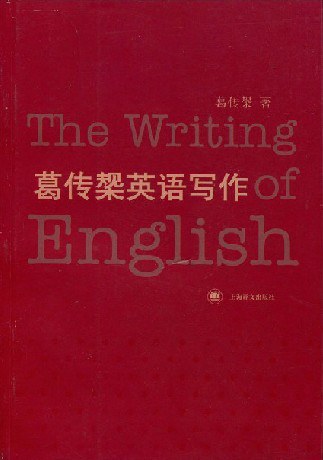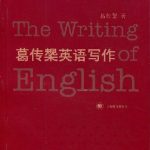
内容简介
葛传椝(1906—1992),我国英语学界泰斗,著有《英汉四用词典》、《新英汉词典》(主要编纂者之一)及《英语惯用法词典》等,影响深远,恩泽几代学人。
目录
CHAPTER I INTRODUCTION 1. Composition and Compositions 2. Purpose of This Book 3. Your Advantage 4. Your Special Difficulties 5. Rhetoric CHAPTER II MECHANICS OF COMPOSITION 6. Materials 7. One Side or Two Sides? 8. Margins 9. Spacing 10. Titles 11. Paging 12. Folding 13. Endorsing 14. Spelling 15. Syllabication 16. Underlining 17. Italics 18. Omissions, Corrections, and Insertions 19. A Warning CHAPTER III LEARNING TO WRITE 20. Something to Say 21. How to Say It 22. A Consolation 23. Others May Have Said It before You 24. What to Read 25. How to Read 26. Some Dictionaries Recommended 27. Self-cultivation 28. Writing from Memory 29. Imitation, Conscious and Unconscious 30. Reading Dictionaries 31. Expressing Another Person’s Thoughts 32. Paraphrasing Sentences 33. Suggestions for Paraphrasing 34. Paraphrasing Paragraphs 35. Paraphrasing Verse 36. Condensing 37. Various Degrees of Condensation 38. Suggestions for Condensing 39. Using Materia1 in Han 40. Expressing Your Own Thoughts 41. Keeping a Diary 42. Choosing a Subject 43. Choosing a Title 44. Taking Notes 45. Making an Outline 46. Note-taking and Outline-making in the Head 47. Making Outlines of What You Read 48. Expanding an Outline 49. Practice in Composition CHAPTER IV WRITING CORRECTLY 50. What is Correct English? 51. Usage 52. Present-day Usage 53. Neologisms 54. English and American Usage 55. Good Usage 56. Expressions Outside of Good Usage 57. Colloquialisms Etc in Written English 58. You are Quite Safe 59. How You Violate Usage CHAPTER V WRITING CORRECTLY (Continued) 60. Grammar 61. Idiom 62. Grammar and Idiom 63. About the Study of Grammar 64. About the Study of Idiom 65. Some Books Recommended 66. Make Your Own Dictionary of Usage 67. Exercises in Grammar 68. Proper Nouns Used as Common Nouns 69. Nouns Used as Adjectives 70. Singulars and Plurals 71. Nouns Singular Only 72. Nouns Plural Usually or Plural Only 73. Nouns Plural in a Special Usage 74. Nouns of Multitude 75. Abstract Nouns in Plural 76. Material Nouns in Plural 77. Nouns Ending in “-ics” 78. Some Miscellaneous Nouns 79. Numerals in Plural 80. Number in Nouns Used as Adjectives 81. Number and Articles 82. Plural Subject with Singular Verb 83. Some Knotty Points of Number 84. Gender and Sex 85. Male or Female Beings Considered Neuter 86. Animals Considered Masculine or Feminine Without Reference to Sex 87. Sexless Things Considered Masculine or Feminine 88. Masculine and Feminine Nouns Used as Nouns of Common Gender 89. Feminine Nouns Ending in “-ess” 90. Nouns Ending in “-man” 91. Words of Common Gender Made Masculine or Feminine 92. Gender and Number 93. Possessive Case and Of-phrase 94. Subjective and Objective Meanings 95. Possessive Plurals 96. Noun Phrases and Possessive Case 97. “’S” Repeated and “Of” Repeated 98. Possessive Case and Lifeless Things 99. Idiomatic Uses of Possessive Case 100. Noun Omitted after Possessive 101. “Of” before Possessive 102. One Noun in Two Cases 103. Pronoun and its Antecedent 104. Lack of a Common-gender Third-person-singular Pronoun 105. A Question of Person 106. Case in Pronouns 107. Objective Used as Predicate Nominative 108. Interrogative “Who” Used as Objective 109. Relative “Whom” Used as Nominative 110. “Whom” Used after “Than” 111. Nominative or Objective after “But”? 112. A Curious Case of Agreement 113. National, Editorial, and Generic Uses of “We” 114. Generic Use of “You” and “Your” 115. Indefinite Use of “They” 116. Generic Use of “One” and “One’s” 117. Idiomatic Uses of “It” 118. Two Distinct Constructions of “It … That” 119. Defining and Non-defining Relative Clauses 120. The Relative Pronouns “Who”, “Which”, and “That” 121. Three Points of Choice between “Who(m)” and “Which” 122. Two Relative Clauses Linked by “And” or “But” 123. Omission of Relative Pronouns 124. “Which” without Definite Antecedent 125. “As” as Relative Pronoun 126. “Who” as Indefinite Relative Pronoun 127. “What” Preceding Statement 128. “One Another” and “Each Other” 129. Adjectives Used as Nouns 130. Exact Senses of Adjectives 131. A Curious Point about Comparatives 132. Two Curious Uses of Superlatives 133. “A Most” Followed by Adjective 134. “Worth” Taking an Object 135. “The Matter” 136. “Nothing Much” 137. Articles 138. “A” and Abstract Nouns 139. Some Words Often Mistaken for Abstract Nouns 140. Generic Use of Articles 141. Position of “A” (or “An”) 142. “The” Giving Common Noun Abstract Sense 143. Articles and Proper Nouns 144. Omission of Articles 145. Repetition of Articles 143. Final Remarks on Articles 147. Transitive and Intransitive Verbs 148. Absolute Use of Transitive Verbs 149. Copulative Verbs 150. Factitive Verbs 151. Verbs Taking Double Object 152. Tense and Time 153. Present Tense Referring to Future 154. Present Tense Referring to Past 155. Past Tense Referring to Future 156. Present Perfect Tense vs Past Tense 157. Past Perfect Tense 158. Perfect Tense vs Factitive “Have” with Past Participle as Complement 159. Continuous Tenses 160. “Always” with Continuous Tenses 161. “Be” in Continuous Tenses 162. “Used” Followed by Infinitive 163. “Be” Followed by Infinitive 164. “Have” Followed by Infinitive 165. Infinitive without “to” 166. Split Infinitives 167. “To” Standing for Infinitive 168. “To” Followed by Gerund 169. Infinitive or Gerund? 170. “Enough” Qualified by Infinitive 171. “Too” Qualified by Infinitive 172. Active and Passive Infinitives 173. Active and Passive Gerunds 174. Gerunds Used as Adjectives 175. Gerund and Possessive 176. Fused Participles 177. Present Participle Separated from Subject by Predicate Verb 178. Unattached Participles 179. Intransitive Past Participles Used as Adjectives 180. “Shall” and “Will”, “Should” and “Would” 181. Subjunctive Mood 182. Sequence of Tenses 183. “The” as Adverb 184. Double Adverbial “The” 185. Quasi-adverbs 186. Prepositions 187. Idiomatic Uses of Prepositions 188. Prepositions before Particular Nouns 189. Prepositions after Particular Words 190. Omission of Prepositions 191. Prepositions Governing Words Other than Nouns and Pronouns 192. That-clause in Apposition to Nouns 193. That-clause Qualifying Adjectives and Past Participles 194. That-clause Used after Verbs 195. That-clause Qualifying “So” and “Such” 196. Idiomatic Uses of “That” 197. Omission of “That” 198. “And” Expressing Result 199. “Or” Meaning Otherwise 200. Idiomatic Uses of “If” 201. “Than” with Ellipsis 202. “When” as Relative Conjunction 203. “As Well As” 204. “Though … Yet …” 205. Indirect Questions 206. Negative Inversion CHAPTER VI WRITING WELL 207. What is Good Writing? 208. Superstitions 209. Diction and Sentence Structure 210. The Exact word 211. Specific and General Words 212. Plain and Pretentious Words 213. Idiomatic Phrases and Idiomatic Uses of Plain Words 214. “Fine Writing” 215. Hackneyed Phrases 216. Words Used Too Often 217. Economy of Words 218. Periodic and Loose Sentences 219. Qualities of a Good Sentence 220. Unity 221. Coherence 222. Emphasis 223. Euphony CHAPTER VII PARAGRAPHS 224. What is a Paragraph? 225. Length of Paragraphs 226. Paragraphs and Outline 227. Topic Sentence 228. Paragraph Development 229. Qualities of a Good Paragraph 230. Transition between Paragraphs Chapter VIII FORMS OF COMPOSITION 231. Narrations, Description, Exposition and Argument 232. Point of View in Narration 233. What Tense to Use? 234. “Story Style” and “News Style” 235. Plain Account of Events 236. Artistic, Practical, and Scientific Description 237. Avoid “Fine Writing” 238. What is Beautiful Language? 239. Examples of Artistic Description 240. Practical Description 241. Exposition is Explanation 242. Definition 243. What to Avoid in Exposition 244. Examples of Exposition 245. Argument and Exposition 246. Question and Answer 247. What to Avoid in Argument 248. Formal and Informal Argument · · · · · · (收起)文件下载








